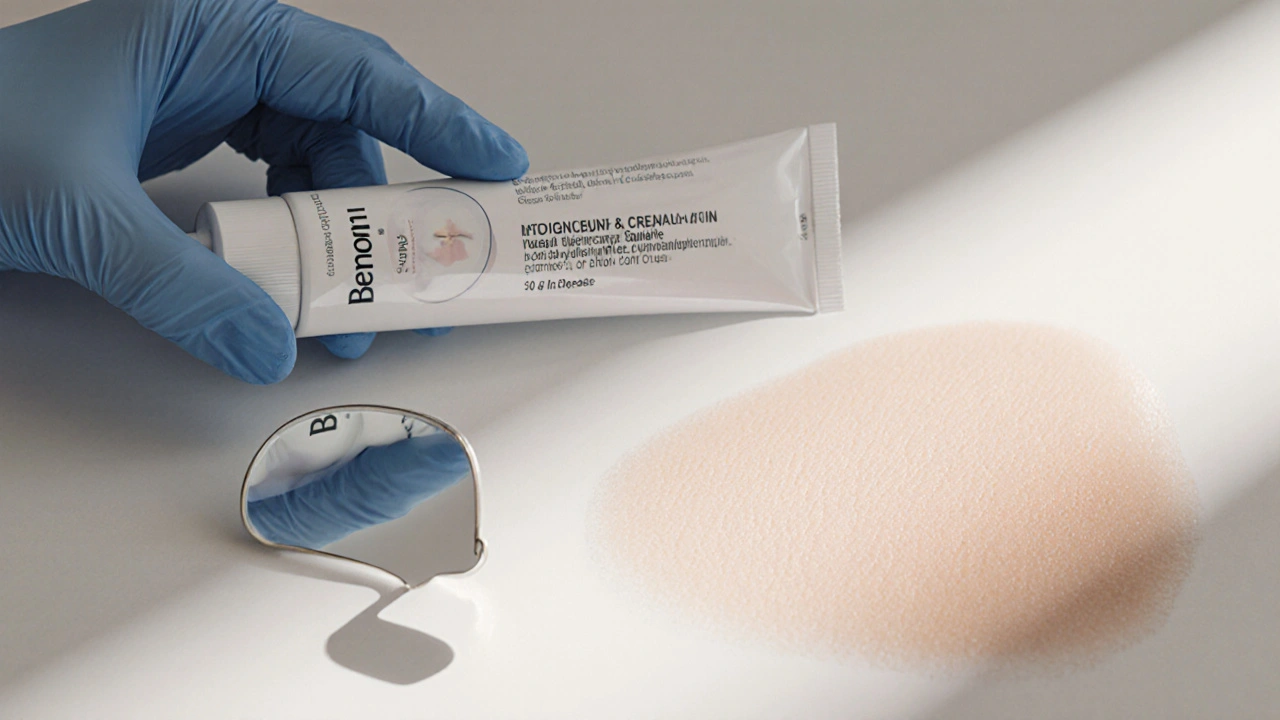
Depigmentation Option Selector
Find Your Ideal Depigmentation Treatment
Select your preferences to see which depigmentation options best match your needs and circumstances.
Your Preferences
Results
Choose your preferences and click "Find My Best Option" to see recommendations.
Quick Summary
Benoquin cream is a potent monobenzone formulation used for total skin depigmentation, but it isn’t the only option. This guide breaks down how Benoquin stacks up against five common alternatives, covering efficacy, safety, cost, and practical use so you can decide what fits your skin goals and lifestyle.
What Is Benoquin Cream?
When you see Benoquin Cream is a prescription‑only monobenzone cream (typically 20% w/w) designed to permanently lighten skin by destroying melanocytes. It was originally developed for extensive vitiligo but is now used by people seeking full‑body depigmentation for cosmetic or personal reasons.
Key attributes of Benoquin Cream:
- Active ingredient: Monobenzone
- Typical concentration: 20% (w/w)
- Application: twice daily on clean, dry skin
- Onset of visible lightening: 2-4 weeks
- Full depigmentation timeline: 6-12 months
- Common side effects: itching, mild burning, temporary hyperpigmentation patches
Why Compare Alternatives?
Monobenzone works by permanently destroying pigment cells, which means results are irreversible. Not everyone wants that level of commitment, and some patients experience intolerable irritation. Plus, Benoquin can be pricey and isn’t covered by most insurance plans. Knowing the trade‑offs helps you pick a route that matches your tolerance, budget, and desired permanence.
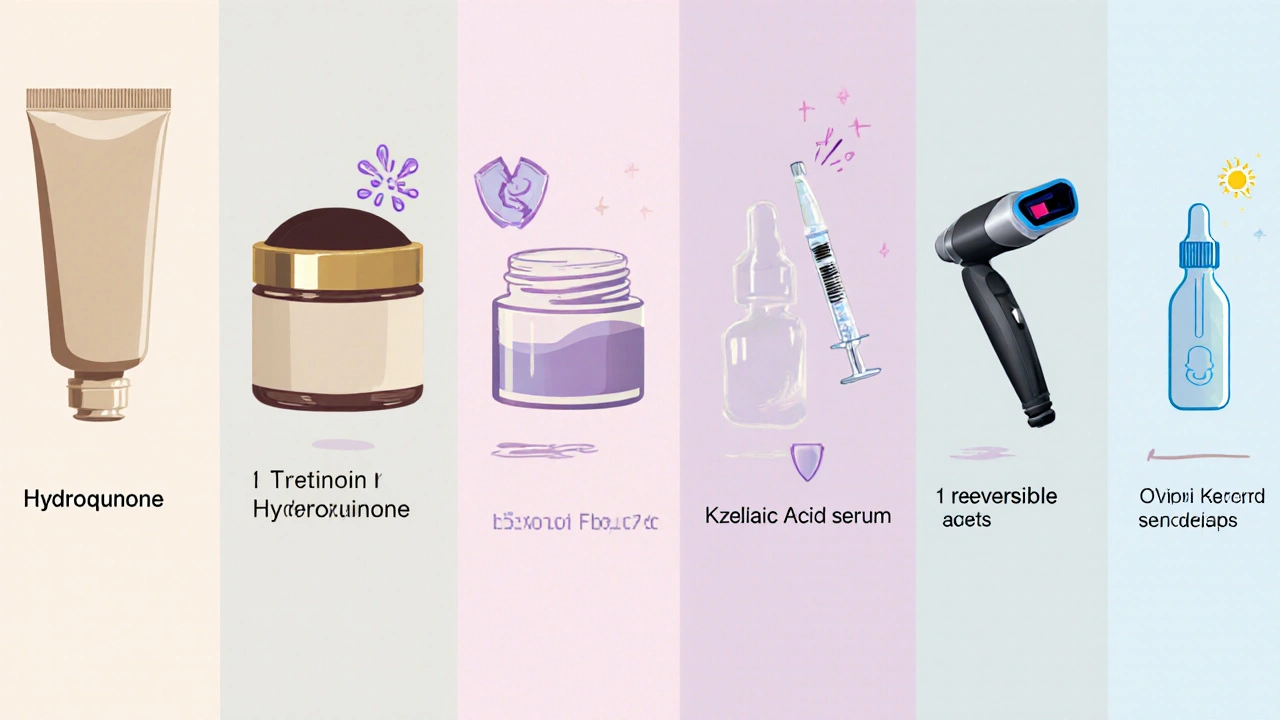
Top Alternatives to Benoquin Cream
Below are the most frequently mentioned options, each with its own mechanism and profile.
1. Hydroquinone 4% Cream
Hydroquinone Cream is a widely available topical skin lightener that inhibits melanin production by blocking the enzyme tyrosinase. It’s sold over‑the‑counter in many countries at 2% and by prescription at 4%.
- Concentration: 4% (prescription)
- Effect: Gradual lightening over 8-12 weeks
- Reversibility: Effects fade after discontinuation
- Side effects: Mild irritation, rare ochronosis with long‑term use
- Cost: $15-$30 for a 30g tube
2. Tretinoin‑Hydroquinone Combination
Tretinoin Cream is a retinoid that speeds up skin cell turnover, often paired with hydroquinone for a synergistic fade. The combo is known as “Kligman’s formula.”
- Typical mix: 0.05% tretinoin + 4% hydroquinone
- Duration: Noticeable results in 4-6 weeks
- Side effects: Peeling, redness, photosensitivity
- Cost: $30-$45 per month
3. Azelaic Acid Gel (20%)
Azelaic Acid is a naturally occurring dicarboxylic acid that both inhibits melanin synthesis and has antibacterial properties. Used for melasma, post‑inflammatory hyperpigmentation, and mild vitiligo.
- Concentration: 20% gel
- Application: Twice daily
- Results: 5-8 weeks for 10-30% lightening
- Side effects: Tingling, mild dryness
- Cost: $25-$35 for a 30g tube
4. Kojic Acid Serum
Kojic Acid is a fermentation‑derived antioxidant that blocks tyrosinase activity. Popular in cosmetic serums for spot‑treatment.
- Typical strength: 2-4% in serum form
- Usage: Once daily after cleansing
- Timeline: 8-12 weeks for subtle fading
- Side effects: Potential sensitization, especially on sensitive skin
- Cost: $20-$40 for 30ml
5. Laser Skin Resurfacing
Laser Skin Resurfacing employs fractional lasers (e.g., Er:YAG, CO₂) to remove pigmented epidermal layers and stimulate collagen remodeling. Works for localized hyperpigmentation and can be part of a broader depigmentation strategy.
- Sessions needed: 3-6, spaced 4-6 weeks apart
- Effect: Immediate lightening of treated spots
- Side effects: Redness, swelling, rare scarring
- Cost: $200-$600 per session
Comparison Table
| Attribute | Benoquin Cream (Monobenzone) | Hydroquinone 4% | Tretinoin‑Hydroquinone | Azelaic Acid 20% | Kojic Acid Serum | Laser Resurfacing |
|---|---|---|---|---|---|---|
| Mechanism | Melanocyte destruction (permanent) | Tyrosinase inhibition (reversible) | Tyrosinase inhibition + accelerated turnover | Tyrosinase inhibition + anti‑inflammatory | Tyrosinase inhibition | Physical removal of pigment layers |
| Concentration | 20% w/w | 4% w/w | 0.05% tretinoin / 4% hydroquinone | 20% gel | 2-4% serum | Variable (laser settings) |
| Typical onset | 2-4 weeks | 8-12 weeks | 4-6 weeks | 5-8 weeks | 8-12 weeks | Immediately after each session |
| Full results | 6-12 months (permanent) | 3-6 months (reversible) | 3-5 months (reversible) | 4-6 months (partial) | 6-9 months (partial) | After 3-6 sessions |
| Side‑effect profile | Itching, burning, occasional vitiligo‑like patches | Mild irritation, rare ochronosis | Peeling, photosensitivity | Tingling, dryness | Sensitization, especially on broken skin | Redness, swelling, rare scarring |
| Cost (average) | $200-$350 per 30g tube | $15-$30 per tube | $30-$45 per month | $25-$35 per tube | $20-$40 per bottle | $200-$600 per session |
| Prescription needed? | Yes (specialty) | Only for 4% strength | Yes | Usually prescription‑only | Often OTC | Yes (clinical) |
How to Choose the Right Option
Think of the decision as a checklist:
- Desired permanence. If you want a permanent, all‑over loss of pigment, Benoquin is the only FDA‑approved product for that purpose.
- Skin sensitivity. Mild eczema or rosacea patients often struggle with the burning of monobenzone. Azelaic acid or low‑strength hydroquinone may be gentler.
- Budget. Laser sessions can add up quickly, while a tube of hydroquinone stays under $30.
- Location of pigment. For patchy facial melasma, a combination of tretinoin and hydroquinone works well. For full‑body depigmentation, Benoquin is purpose‑built.
- Medical supervision. Monobenzone requires a dermatologist’s monitoring, whereas OTC kojic acid can be tried at home with caution.
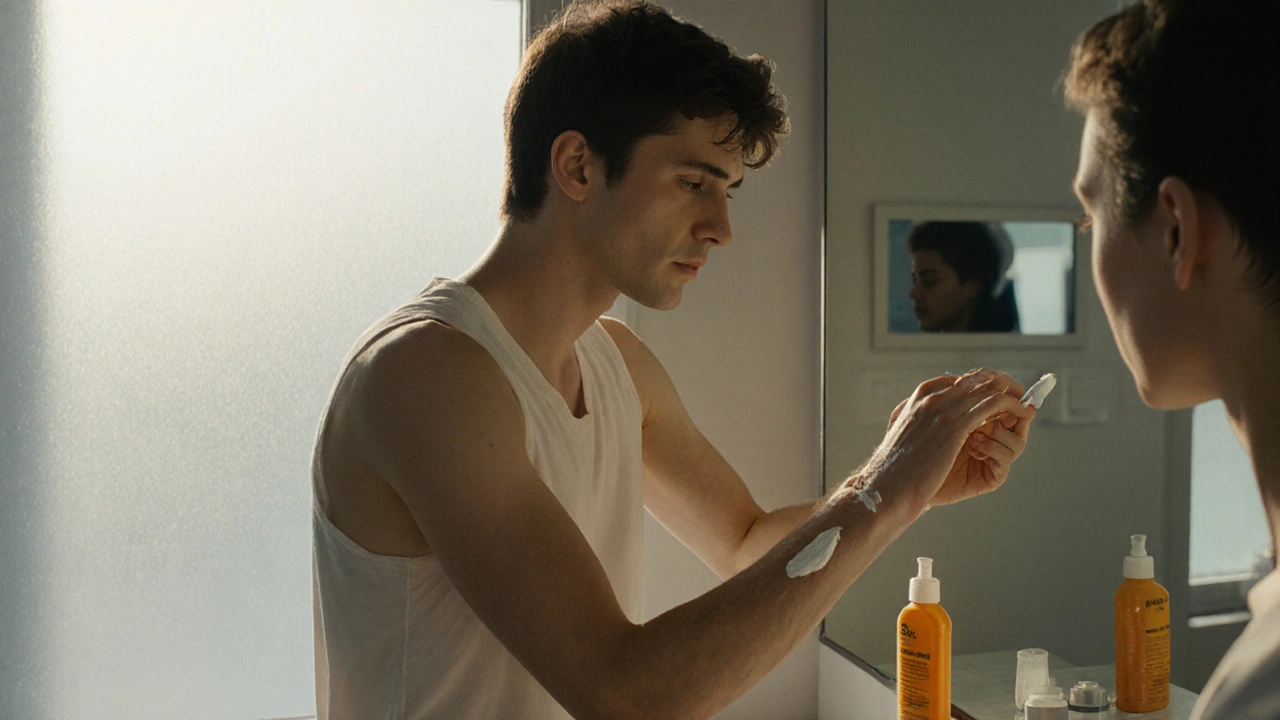
Safety Tips & Common Pitfalls
Regardless of the product you pick, keep these safeguards in mind:
- Always perform a 48‑hour patch test before full‑face application.
- Use broad‑spectrum sunscreen (SPF30+) daily; many depigmenting agents increase UV sensitivity.
- Do not combine multiple strong agents (e.g., hydroquinone + high‑strength retinoid) without dermatologist guidance.
- Monitor for unexpected dark spots. If they appear, stop treatment and consult a professional.
- Stay consistent. Skipping days can prolong the timeline and heighten irritation.
Real‑World Experiences
Emma, 29, used Benoquin for a full‑body tattoo cover‑up. She reported a steady fade over nine months but needed weekly dermatologist visits to manage itching. Meanwhile, Carlos, 35, opted for a hydroquinone‑tretinoin mix for melasma. He saw significant improvement in three months with minimal side effects, but the results faded after six months when he stopped using the cream.
These anecdotes highlight the trade‑off between lasting results and ongoing maintenance.
Bottom Line: Which One Is Best for You?
If you’re ready for a permanent, uniform lightening and can handle prescription logistics and possible irritation, Benoquin remains the gold standard. For those who prefer reversible, spot‑focused treatment, start with lower‑strength hydroquinone or azelaic acid. When budget or access to a dermatologist is limited, kojic acid offers a modest, over‑the‑counter alternative. And for stubborn, localized spots, laser resurfacing provides a fast, albeit pricey, fix.
Frequently Asked Questions
Is Benoquin Cream safe for long‑term use?
Benoquin is approved for permanent depigmentation, but long‑term safety depends on regular monitoring. Most users experience mild irritation that can be managed with moisturizers and intermittent breaks. Dermatologists advise periodic skin checks to catch any unexpected pigment changes early.
Can I switch from Benoquin to another product later?
Because monobenzone destroys melanocytes, the lightening is irreversible. If you stop using the cream, the skin won’t regain its original color. Switching to a reversible agent won’t bring back pigment; it can only address new hyperpigmentation that may develop.
How does the cost of Benoquin compare to laser treatments?
A 30g tube of Benoquin ranges from $200 to $350 and typically lasts several months with twice‑daily use. Laser resurfacing costs $200-$600 per session, and most patients need 3-6 sessions. Over a year, the total laser expense can match or exceed the cost of a single tube of Benoquin, especially if maintenance sessions are required.
Are there any natural alternatives that work as well as monobenzone?
Natural options like kojic acid or licorice extract can lighten spots, but they achieve only modest, reversible changes. None match the permanent, full‑body effect of monobenzone. They’re better suited for mild hyperpigmentation or as adjuncts to other treatments.
Do I need sunscreen while using any of these depigmenting agents?
Yes. All depigmenting agents increase UV sensitivity, making sun protection essential. Use a broad‑spectrum SPF30 or higher, reapply every two hours, and consider physical blockers like zinc oxide for added safety.

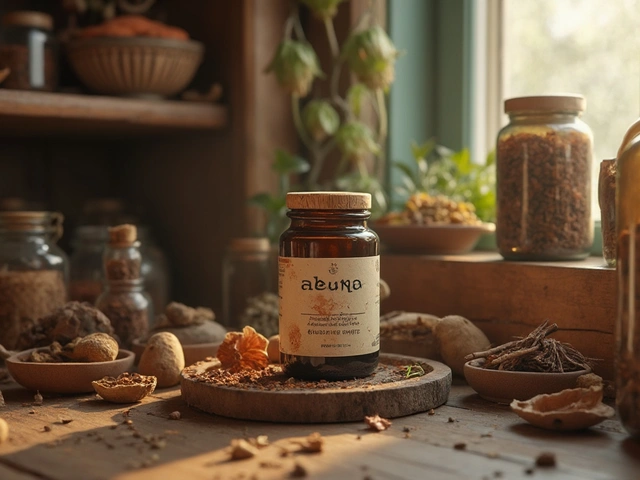


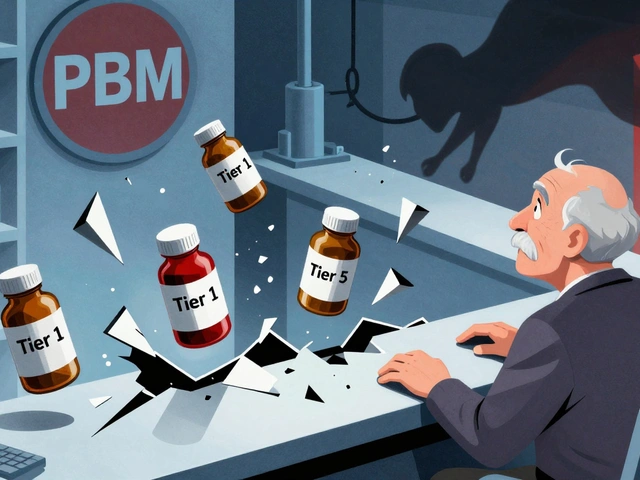


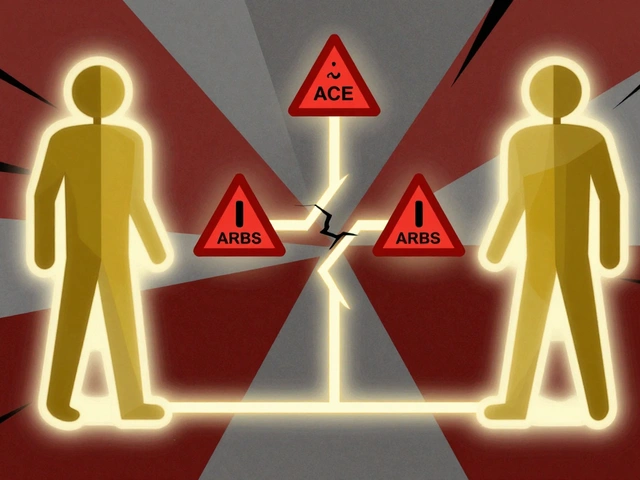
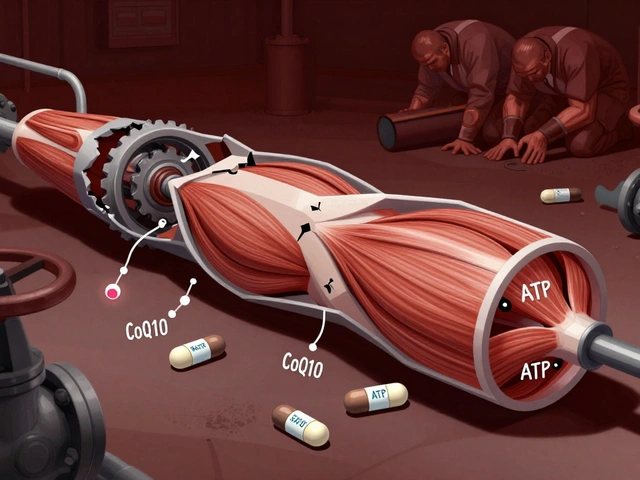
13 Comments
Look, if you believe Benoquin is the only ticket to a complete skin reset, you’re buying into the hype like it’s the latest miracle diet – all hype, no substance, and a side of nasty irritation.
Honestly, turning your skin into a blank canvas without considering the ethical implications is relesh. It’s not just about cost; it’s about the long‑term health risks you might be ignoring, and that’s simply unacceptable.
When evaluating depigmentation methods, it helps to map your priorities: permanence, skin sensitivity, and budget. A quick matrix can keep the conversation focused and prevent the debate from spiraling into anecdotal territory.
The quest for permanent depigmentation is not merely a cosmetic preference, it is a profound decision that reshapes identity. Monobenzone, the active ingredient in Benoquin, works by irrevocably destroying melanocytes, a mechanism that guarantees lasting results but also eliminates any chance of reversal. From a pharmacological standpoint, this irreversible action sets it apart from agents like hydroquinone or azelaic acid, which merely suppress melanin synthesis. Patients must therefore weigh the permanence against the potential for chronic irritation, which can manifest as itching, burning, or sporadic hyperpigmented patches. Clinical data suggest that a majority of users see noticeable lightening within a month, yet the full transition to a uniform tone can stretch over six to twelve months. Financially, a single 30‑gram tube may cost upwards of three hundred dollars, a price point that rivals a series of laser sessions. However, the cumulative expense of laser therapy, often requiring three to six appointments at several hundred dollars each, can quickly eclipse the cost of monobenzone. Legal considerations also play a role, as Benoquin is prescription‑only and mandates regular dermatologist oversight to monitor adverse reactions. In contrast, over‑the‑counter options such as kojic acid or low‑strength hydroquinone present a lower barrier to entry but lack the decisive effectiveness of monobenzone. The paradox lies in the fact that while cheaper alternatives may be gentler, they often demand strict adherence and extended timelines to achieve modest improvements. From a patient‑centric perspective, the decision matrix should therefore incorporate not just the end goal but also lifestyle compatibility, such as willingness to attend frequent check‑ups. If one’s skin is highly sensitive, switching to azelaic acid, which offers anti‑inflammatory benefits, may mitigate adverse events. Conversely, for individuals seeking a full‑body depigmentation, the only FDA‑approved path remains monobenzone, making it the default choice despite its drawbacks. Ultimately, the dialogue between dermatologist and patient must be transparent, acknowledging both the psychological impact of permanent skin changes and the medical responsibilities involved. Only through this informed partnership can one navigate the treacherous terrain between aesthetic desire and physiological safety.
Wow, the whole monobenzone saga feels like a secret society controlling our skin tones 🕵️♀️! They don’t tell you that the “permanent” label is a double‑edged sword, and the market pushes cheap serums that are basically a placebo 😒. I’m convinced there’s a hidden agenda to keep us buying endless products while the real solution is provied behind a prescription pad 😈.
Actually, the previous comment contains several grammatical errors: “doesn’t” should be “does not”, and “they don’t tell you” needs a comma after “you”. Also, “secret society” is a cliché. 😉
Skin color is just a surface story, the real us is deeper than any cream.
Alright, let’s break this down for anyone who’s still on the fence: you’ve got the cheap over‑the‑counter stuff, the mid‑range combos like tretinoin‑hydroquinone, and the high‑end laser routes, each with their own pros and cons. If you’re on a shoestring budget, start with a 2 % hydroquinone gel – it’s affordable and you can see results in a couple of months, but you need to be diligent about sunscreen. For those who can spare a bit more cash, the tretinoin‑hydroquinone mix offers faster turnover and a smoother texture, though you’ll have to tolerate some peeling. And if you’re truly serious about full‑body depigmentation, Benoquin is the only FDA‑approved option, albeit with a price tag that can make your wallet weep. Laser treatments sit somewhere in the middle, delivering quick spot‑lightening for stubborn patches but demanding multiple sessions and a hefty per‑visit bill. Bottom line: match the treatment to your goals, sensitivity, and financial comfort, and never skip the daily SPF – it’s the unsung hero of any lightening regimen.
i think the best tip is to always test a tiny area first and wear sunscreen like it’s your second skin
Not every brightening agent works for everyone.
Remember, the journey to an even skin tone is a marathon, not a sprint; stay consistent with your chosen regimen, track any changes, and keep your dermatologist in the loop for adjustments.
One must wonder whether the pharmaceutical giants are deliberately suppressing monobenzone’s widespread availability to protect their lucrative line of reversible creams, a stratagem that only becomes apparent when you examine the lobbying expenditures behind the FDA’s approval process.
In the end, if you’re an American who values freedom of choice, you should demand that our doctors be allowed to prescribe Benoquin without red‑tape – no more bureaucratic nonsense.